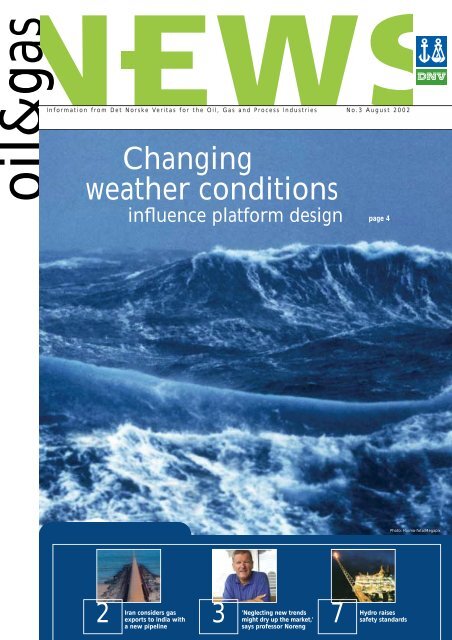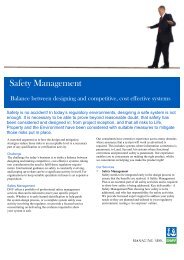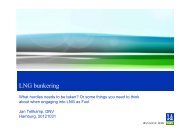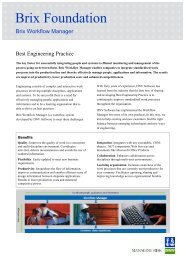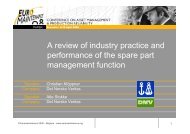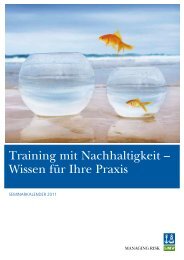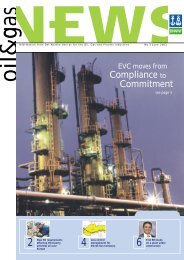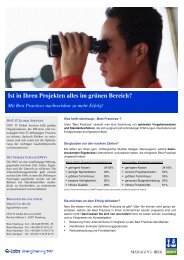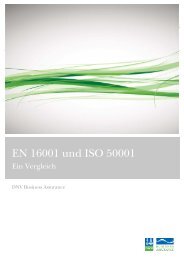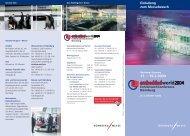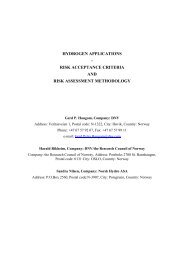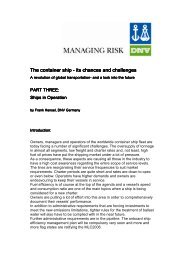Iran considers gas
Iran considers gas
Iran considers gas
Create successful ePaper yourself
Turn your PDF publications into a flip-book with our unique Google optimized e-Paper software.
oil&<strong>gas</strong> g<br />
Information from Det Norske Veritas for the Oil, Gas and Process Industries No.3 August 2002<br />
Changing<br />
weather conditions<br />
2 <strong>Iran</strong><br />
influence platform design<br />
<strong>considers</strong> <strong>gas</strong><br />
exports to India with<br />
a new pipeline<br />
3 'Neglecting<br />
new trends<br />
might dry up the market,'<br />
says professor Noreng<br />
7 Hydro<br />
page 4<br />
raises<br />
safety standards<br />
Photo: Husmo-foto/Megapix
During the whole life of the oil and <strong>gas</strong> industry,<br />
the actors have had to face continuous change.<br />
Those able to adapt have survived, while many<br />
have disappeared.<br />
The variety of challenges coming up now might<br />
be larger than ever. The new industry structure<br />
with old players disappearing and new emerging<br />
creates few, but large companies, and a variety<br />
of specialised niche companies introducing completely<br />
new business models.<br />
Many fields to be developed require technology<br />
that is not technically or commercially proven, and<br />
the industry’s ability to attract the right talents<br />
will be critical.<br />
We have also seen indications that environmental<br />
issues affect the industry in various ways. The<br />
demands on cleaner production will affect the<br />
industry, but there are indications of climate<br />
change materialised as higher waves and<br />
stronger winds, which will affect the integrity of<br />
existing installations.<br />
Our intention is not only to be one of the<br />
survivors in the industry, but also to assist our<br />
customers in finding solutions to some of these<br />
challenges. Some examples are given in this<br />
edition of Oil & Gas News.<br />
Elisabeth Harstad<br />
Chief Operating Officer<br />
DNV Technology Services<br />
Facing<br />
continuous<br />
change<br />
2 Oil & Gas News 3 – 2002<br />
Deeper challenges<br />
in the pipeline<br />
Holding the world’s second-largest reserves of natural<br />
<strong>gas</strong>, <strong>Iran</strong> is now considering <strong>gas</strong> exports to India. DNV is<br />
evaluating the technical challenges of a pipeline reaching<br />
greater depths than ever before.<br />
DNV has signed a contract with the National <strong>Iran</strong>ian Oil Company<br />
(NIOC) for a <strong>gas</strong> pipeline feasibility study, similar to that of the Blue<br />
Stream project across the Black Sea.<br />
DNV is to help in evaluating whether it is technically possible to build<br />
such an offshore pipeline from <strong>Iran</strong> beneath the Indian Ocean. The<br />
project poses new technological challenges to the DNV pipeline and<br />
materials engineers, as this pipeline would reach greater depths than<br />
any other offshore pipeline. If the <strong>Iran</strong>-India pipeline were to be<br />
built, it would be over three times the length of the 390 km long,<br />
2,150 m deep Blue Stream, and reach a depth of 3,500 m.<br />
Among the problem areas DNV will consider in the feasibility study<br />
are the structural strength, material properties and hydraulic conditions<br />
(flow and hydrates) exposed to the tremendous pressure at<br />
such a depth. The installation process and the difficult conditions on<br />
the ocean floor in the Indus Delta will also be evaluated.<br />
DNV will verify studies carried out by Snamprogetti and Saipem.<br />
The pipeline project is a cooperation between NIOC and the Gas<br />
Authority of India Limited.<br />
For further information, contact:<br />
Nils.Andreas.Masvie@dnv.com
Fighting maturity<br />
by diversity<br />
‘There is an urgent need to meet the challenges and trends facing the oil and<br />
<strong>gas</strong> industry today,’ says Professor Øystein Noreng at the Norwegian School<br />
of Management. ‘Neglecting them could lead to reduced profitability and<br />
stagnation, and the danger of drying up the market. The key is cooperation.’<br />
Noreng sees new trends emerging: an<br />
increased two-way split of the market,<br />
with smaller companies gradually taking<br />
larger shares of the upstream business,<br />
while the large oil companies concentrate<br />
on downstream business. The average<br />
field size is decreasing as oil<br />
provinces mature, while research and<br />
development are steadily drying up.<br />
Admission ticket<br />
‘One way to succeed is to change the<br />
existing allocation policy in some of the<br />
oil nations,’ says Noreng. ‘The present<br />
situation in Norway is a good example,<br />
where almost all of the operators in the<br />
North Sea are the largest oil companies<br />
in the world such as Statoil, BP and<br />
ExxonMobil. I think it is vital to encourage<br />
more foreign and smaller companies<br />
to operate in this area as a means to<br />
increase diversity and pluralism. This will<br />
improve services and knowledge among<br />
• Øystein Noreng is a Professor at the<br />
Norwegian School of Management.<br />
Since 1990 a holder of the FINA Chair in<br />
petroleum economics and management,<br />
currently the TotalFinaElf chair.<br />
• Noreng has degrees in history and<br />
economics, M.A. in political science,<br />
University of Oslo, 1967 and a Doctorate<br />
(Ph.D.) in political science at the<br />
University of Paris (Sorbonne I), 1972.<br />
• He has been a post-doctoral research<br />
fellow and Trygve Lie Fulbright fellow at<br />
the Institute of Energy Studies, Stanford<br />
University, 1977-1978. A visiting<br />
research scholar and King Olav V Birthday<br />
Fellow at John F. Kennedy School<br />
of Governmen at the Harvard University,<br />
1986-1987. An adjunct research fellow<br />
at the Centre for Energy and Marine<br />
Transportation, Columbia University,<br />
2002.<br />
all parties involved, and raise chances to<br />
export that knowledge internationally.<br />
There should, however, be an admission<br />
ticket to get a licence, which should<br />
include a documented research and<br />
development policy in each company<br />
to enhance knowledge development in<br />
relation to petroleum in Norway.<br />
I believe that R&D must be increased to<br />
gain more efficiency and profitability out<br />
of existing resources.’<br />
Weakening advantage of<br />
large-scale business<br />
Øystein Noreng has just finalised a<br />
report for the Norwegian Ministry of<br />
Petroleum and Energy, focusing on<br />
structural changes and trends in the oil<br />
and <strong>gas</strong> industry.<br />
‘One way to succeed is to change<br />
the existing allocation policy in<br />
some of the oil nations,’<br />
says Professor Noreng.<br />
In it he concludes that the tendency in<br />
upstream operations is that smaller and<br />
medium-size oil companies are gradually<br />
winning more of the reserves and recovery<br />
volume. At the same time large oil<br />
companies with extensive technological<br />
and economic resources are concentrating<br />
on large oil fields in new areas, heavy<br />
in capital and time, while smaller companies<br />
concentrate on smaller projects in<br />
mature areas which are less resourcedemanding.<br />
The heterogeneity in the<br />
resource basis and the prospect portfolio<br />
will weaken the advantage of large-scale<br />
business.<br />
The balance between large and small<br />
companies upstream, therefore, is being<br />
displaced in favour of the latter due to<br />
more small projects available than large.<br />
Øystein Noreng, does not<br />
believe any new oligopoly will<br />
dominate the industry<br />
Consolidation<br />
Development in up- and downstream<br />
activities is changing. Downstream is<br />
constantly facing stricter requirements<br />
for product quality and discharge, which<br />
require new investment. This gives a<br />
large-scale operation advantage and is<br />
the reason behind recent mergers, in<br />
addition to the need to secure raw oil<br />
access. The need for the large oil companies<br />
to secure access to natural <strong>gas</strong> is also<br />
pressing, and the result is a consolidation<br />
of refining and distribution of products,<br />
reduced competition and perhaps a<br />
long-term trend toward higher downstream<br />
margins.<br />
Diversity<br />
In mature oil nations such as the U.S.,<br />
Canada and Great Britain new oil companies<br />
are being created based on technology<br />
and capital available in the<br />
market. Many new suppliers are entering<br />
the upstream oil and <strong>gas</strong> business. The<br />
question Noreng raises in his report is<br />
whether a long-term tendency of larger<br />
multiplicity might result in increased<br />
competition: at least he does not believe<br />
any new oligopoly will come to dominate<br />
the industry.<br />
Beate.V.Orbeck@dnv.com<br />
Photo: Scanpix<br />
Oil & Gas News 3 – 2002 3
Future perspective<br />
Changing weather con<br />
and the effect on offshore installa<br />
Recent ship losses in the North Atlantic and the North Sea have been due to giant waves of exceptional height<br />
and abnormal shape. Design of new platform concepts in deepwater fields requires a thorough knowledge<br />
of the environmental climate and a detailed assessment of loading and platform response.<br />
Since offshore activities started in the North Sea, DNV has been<br />
active in developing new methods and computational tools for<br />
load and response assessment of offshore structures. Numerical<br />
and probabilistic analyses have become key elements to ensure<br />
safe operation of offshore installations.<br />
During the past 10 years climate change due to the greenhouse<br />
effect has received a lot of attention. Some reviews have indicated<br />
a gradual increase in mean and significant wave heights during<br />
the past 30 years, which has caused concern in the offshore<br />
industry that previous long-term extreme load predictions may<br />
need to be reconsidered. Others have concluded that extreme<br />
events occur more frequently than before, supporting a belief<br />
that the climate may show an unstable trend.<br />
Before any conclusions can be made it is important to determine<br />
whether the observations reported are a result of local phenomena<br />
or a general feature of the North Atlantic, and whether<br />
they are oscillations of the ocean-atmosphere system in natural<br />
long-term variations, or trends due to climate changes.<br />
4 Oil & Gas News 3 – 2002<br />
More accurate recording<br />
The reported increase of wave heights could be due to improvements<br />
and changes of instrumentation and observation practices.<br />
Early ship-borne wave records have been unable to monitor<br />
the effect of high frequencies. New laser and radar measuring<br />
techniques are able to resolve higher crests than traditional wavebuoy<br />
techniques. Wave statistics can also be affected in heavy sea<br />
states when measurements are interrupted, which previously<br />
occurred more frequently. These early measured wave heights<br />
may therefore exhibit a negative bias and the temporal development<br />
will show a spurious upward trend. It turns out that<br />
modern ways of measuring wave heights, like laser and radar<br />
techniques, are able to measure more accurately higher wave<br />
crests. Data indicating very high wave crests were earlier considered<br />
not reliable and sometimes removed from the time series.<br />
Numerical ocean response models<br />
Since natural long-term variations occur, a long-term history of<br />
measured data is needed to establish appropriate environmental
ditions Photo:<br />
ions<br />
Husmo-foto/Megapix<br />
design criteria for specific projects. In the absence of such data<br />
the hindcast method must be applied. The method calibrates<br />
numerical ocean response models for wave and current, based<br />
on time and space evolution of the surface marine wind field. To<br />
investigate the effect of climate changes, the Norwegian project<br />
Regional Climate Development Under Global Warming (Reg-<br />
Clim) is estimating probable environmental changes in the<br />
North Sea and major parts of the Arctic, given a global increase<br />
in greenhouse <strong>gas</strong>es. In recent years several ships have been lost,<br />
accidents believed to be due to individual waves of exceptional<br />
height or abnormal shape. Ocean response models have not<br />
been able to forecast such extreme waves with reasonable confidence.<br />
These events have initiated research to improve the modelling<br />
of non-linear waves and their interactions with wind and<br />
currents.<br />
Design issues<br />
There are several design issues for offshore installations involving<br />
interaction between large waves and structures. For buoyancy<br />
tethered structures such as TLPs extremely large and steep waves<br />
may cause high-frequency resonant oscillations known as ringing.<br />
Moored stationary FPSOs are susceptible to large impact forces<br />
due to bow wave slamming and green water. For floating structures<br />
in general, air gap and wave/deck impact is of concern as<br />
well as fatigue of mooring and riser components. In deep water<br />
the current will have a relatively larger effect on the response of<br />
the floater due to loads on the extended length of moorings and<br />
risers. A recent important design issue for SPAR platforms in the<br />
Gulf of Mexico is vortex-induced oscillations of the floater itself<br />
due to strong loop currents. Knowledge of the temporal variation<br />
of these currents is essential for safe design of the structure.<br />
All of the above design issues involve interaction between large<br />
waves and fixed or floating structures. To strengthen the knowledge<br />
base in this area, DNV is presently active in the EU-supported<br />
research projects MAXWAVE, REBASDO and SAFE-<br />
FLOW.<br />
– The MAXWAVE project deals with impact of very large waves<br />
on marine structures. The first part of the project aims at developing<br />
better physical and statistical models for freak waves, the<br />
second addresses wave design criteria for ships and offshore<br />
structures, and the third focuses on improving forecasts including<br />
warnings of extreme wave events.<br />
– The REBASDO project deals with reliability-based design of<br />
FPSO systems. The objective is to develop risk-based methods for<br />
design and safety assessment of FPSO units including mooring<br />
and riser systems. The project will have an impact on future riskbased<br />
rules and codes for structural design. It is important to<br />
establish accurate extreme-value distributions for responses of<br />
floating structures for a given return period. Particular attention<br />
is given to directional wave effects and prediction of wave crest<br />
characteristics.<br />
– The SAFE-FLOW project deals with bow wave slamming and<br />
extreme loads due to green water on the deck of FPSOs. The<br />
project identifies critical wave impact conditions and develops a<br />
methodology for green water impact loading and response calculation.<br />
Future design of offshore installations will focus more on the<br />
effect of interactions between the structure and extreme wind,<br />
waves and current. Attention must be given to environmental<br />
design criteria, ensuring that possible long-term climate change<br />
is taken into account.<br />
Arne.Nestegard@dnv.com<br />
Arne Nestegård is part of the DNV Fellow<br />
scheme. His profession is fluid dynamics. He is a<br />
Doctor of Philosophy from the Massachusetts<br />
Institute of Technology and has a Master of Science<br />
from the University of Oslo.<br />
The purpose of the DNV Fellow scheme is to appoint outstanding<br />
individuals to maintain, develop and propose actions on<br />
core technologies identified as being of particular importance<br />
to DNV, each for an assignment period of three years.<br />
Oil & Gas News 3 – 2002 5
Qualification<br />
Qualifying new<br />
technology at Ormen Lange<br />
DNV has been assigned by Norsk Hydro to assist in qualifying new technology to<br />
identify and mitigate the risks involved at the Ormen Lange field in the North Sea.<br />
Ormen Lange is a major <strong>gas</strong> discovery in<br />
the western part of the Haltenbanken,<br />
located in water depths of about 900 m.<br />
New technology is needed to facilitate<br />
certain areas of the field development,<br />
and as a means of cost reduction.<br />
For Norsk Hydro it is vital to ensure that<br />
the new technology is sufficiently qualified<br />
to perform as intended, and that sufficient<br />
information is available when<br />
decisions are to be made about which<br />
technical solutions are to be implemented.<br />
It relates to risk management and the<br />
ability to identify all uncertainties and to<br />
implement measures to control and mitigate<br />
them.<br />
6 Oil & Gas News 3 – 2002<br />
DNV’s contribution to this process has<br />
included:<br />
•Management of qualification of largebore<br />
downhole safety valves, based on<br />
the DNV Recommended Practice<br />
Qualification Procedures for New<br />
Technology, DNV-RP A203.<br />
• Development of analysis approach<br />
and acceptance criteria for freespanning<br />
pipelines considering vortex-induced<br />
vibrations and interaction<br />
with fishing gear.<br />
• Decision support on new technology<br />
regarding differentiation and selection<br />
of the most desirable full process<br />
offshore concept, either a Spar, Semi<br />
or TLP.<br />
The Ormen Lange field, on<br />
the Haltenbanken in the North Sea<br />
Photo: Hydro Media<br />
• Reliability, Availability and Maintainability<br />
(RAM) analysis for the different<br />
concepts as a basis for concept selection<br />
and optimisation.<br />
Norsk Hydro is the operator and responsible<br />
for the development phase, while<br />
Norske Shell is the operator for the production<br />
phase. Concept selection is to<br />
take place 2002/2003.<br />
Tommy.Bjornsen@dnv.com<br />
POSC Caesar specifications awaken interest<br />
Statoil has successfully adopted parts of the POSC Caesar specifications in implementing new data<br />
warehouses for the Åsgard A and B platforms in the North Sea, and in a development project at<br />
the Kristin platform. The methodology has awakened interest in other parts of the industry too.<br />
The POSC Caesar specifications are<br />
being used as standards for interoperability<br />
and data integration across disciplines,<br />
phases and projects. It is being<br />
developed by the POSC Caesar Standardisation<br />
Organisation in co-operation with<br />
organisations in the U.K., the Netherlands<br />
and the U.S..<br />
Different versions of the specifications<br />
have been used in more than 40 capital<br />
development projects in the oil and <strong>gas</strong><br />
industry. Leading engineering and oil<br />
companies have done extensive testing,<br />
and today most of these companies are<br />
using software based on the specifications.<br />
The methodology has also found<br />
interest in industries such as shipping,<br />
process, aerospace, defence and building<br />
and construction.<br />
Specifications turned into standards<br />
POSC Caesar has a special responsibility<br />
for maintenance and enhancement of<br />
the ISO 15926 standard: Integration of lifecycle<br />
data for process plants including oil and<br />
<strong>gas</strong> production facilities.<br />
ISO 15926 consists of a generic data<br />
model which defines a methodology for<br />
handling information, and a reference<br />
data library that defines the meaning of<br />
terms used in the industry. As the model<br />
is generic it is also applicable across<br />
industries. The only change required to<br />
cover a new area is extensions of the<br />
reference data library. The model can<br />
support all disciplines and life cycle<br />
stages of a facility, data about functional<br />
requirements, physical solutions, type of<br />
objects, individual objects and activities.<br />
Nils.Sandsmark@dnv.com<br />
The POSC Caesar methodology is being used<br />
in a wide range of industries, such as oil<br />
and <strong>gas</strong>, process, shipping and aerospace
Hydro raises its<br />
North Sea safety standards<br />
Norsk Hydro has initiated a comprehensive<br />
project to monitor the status of all<br />
technical safety systems on its offshore<br />
installations in the North Sea. Together<br />
with DNV, a set of new performance standards<br />
has been established for all installations.<br />
Safety system integrity<br />
The principles of the IEC 61508 standard<br />
for design and regular follow-up of safety<br />
system integrity, as one key element<br />
of the company’s safety management<br />
system, have been incorporated. Procedures<br />
for testing, reporting and measurement<br />
of safety system integrity are currently<br />
being implemented for all installations<br />
as an integrated part of the maintenance<br />
management system.<br />
Technical status<br />
To further improve safety standards and<br />
awareness of major accident risk, Norsk<br />
Hydro has initiated a comprehensive<br />
project to record the current technical<br />
status of all technical safety systems<br />
through in-depth reviews of technical<br />
functionality, system integrity, vulnerability<br />
and management systems including<br />
document handling and operator qualifications.<br />
Necessary measures will be<br />
implemented on all plants to improve<br />
the functionality of the safety systems, to<br />
keep major hazard risk at an acceptable<br />
level.<br />
Performance standards<br />
Norsk Hydro has requested DNV to assist<br />
the company in management, planning,<br />
preparation and execution of the project.<br />
It requires detailed technical knowledge,<br />
practical expertise and a good<br />
understanding of the system functionality in<br />
an overall risk perspective.<br />
New regulations on the Norwegian Continental Shelf are putting greater<br />
pressure on the operators to control and manage technical safety. Norsk Hydro<br />
has taken action to monitor the functionality and integrity of technical safety<br />
barriers, considered vital to control major accident risk.<br />
During field development, quantitative<br />
risk analysis and industry standards are<br />
applied to design the safety systems. In<br />
the operational phase maintenance,<br />
inspection and condition assessment are<br />
important activities when assessing technical<br />
conditions of safety barriers. The<br />
human aspects related to competence,<br />
experience and attitude, and the management<br />
systems, are also crucial to<br />
maintain the overall technical performance<br />
in both a short- and long-term perspective.<br />
A set of performance standards for all<br />
technical safety barriers has been established.<br />
Principles for assessing and measuring<br />
of the criticality of findings and<br />
observations have been established to<br />
prioritise compensating measures. The<br />
standards are based on Statoil’s framework<br />
and experience, improved to reflect<br />
Norsk Hydro’s specific technical requirements<br />
for safety systems, operational<br />
practice and special needs. 18 performance<br />
standards have been established as<br />
the key guideline for interviews, document<br />
reviews, visual inspection or performance<br />
tests of safety barriers.<br />
On-site reviews will be carried out on all<br />
Norsk Hydro’s offshore installations in<br />
the North Sea and at the Sture oil terminal<br />
during 2003. The review team will be<br />
managed by DNV and manned with technical<br />
consultants from DNV and Norsk<br />
Hydro to ensure the necessary independence<br />
from daily operations.<br />
Erik.Ostby@dnv.com<br />
Consultancy<br />
The Sture terminal, 60 km north of Bergen<br />
Photo: Hydro Media<br />
From the Oseberg field, located in the North Sea<br />
about 130 km northwest of Bergen<br />
Photo: Hydro Media<br />
Oil & Gas News 3 – 2002 7
New Offshore Codes from DNV<br />
DNV Offshore Codes include Offshore<br />
Service Specifications, Offshore Standards<br />
and Recommended Practices. The<br />
Recommended Practices have been further<br />
expanded by the following new publications:<br />
DNV-RP-A203: Qualification Procedures<br />
for New Technology<br />
A systematic approach to qualification of<br />
new technology ensures that the technology<br />
functions are reliable within specified<br />
limits. The document is applicable<br />
to components, equipment and assemblies<br />
which can be defined as new technology,<br />
in hydrocarbon exploration and<br />
exploitation offshore.<br />
DNV-RP-C102: Structural Design<br />
of Offshore Ships<br />
A description of the activities in a typical<br />
design process, and a guideline for the<br />
application of technical requirements<br />
and acceptance criteria given in the DNV<br />
Offshore Standard OS-C102 for offshore<br />
ships.<br />
DNV-RP-C103: Column-Stabilised Units<br />
Presents recommendations for strength<br />
analyses of the main structures of col-<br />
DNV Offshore Codes online<br />
The DNV Offshore Codes are proving to be<br />
very popular among DNV’s clients. From a<br />
modest start early 2001 the web-site now has<br />
an average of 80 external user sessions per<br />
day. User feedback shows it has become a<br />
preferred choice for reading, searching,<br />
DNV (Det Norske Veritas) is an independent, autonomous Foundation working to safeguard life,<br />
property and the environment. DNV comprises 300 offices in 100 countries, with 5,500 employees.<br />
DNV services to the oil,<br />
<strong>gas</strong> and process industries<br />
We are helping clients within the<br />
following service areas:<br />
• Safety, health and environment<br />
• Qualification and innovation<br />
• Verification and<br />
classification<br />
• Asset operations<br />
For further information,<br />
see www.dnv.com/ogpi<br />
Oil & Gas News 3 – 2002<br />
umn-stabilised units. A guideline for<br />
application of technical requirements<br />
and acceptance criteria given in the DNV<br />
Offshore Standard OS-C103 for columnstabilised<br />
units.<br />
DNV-RP-F105: Free-Spanning Pipelines<br />
Rational design criteria and guidance<br />
for assessment of pipeline-free spans<br />
subjected to combined wave and current<br />
loading. The premises for the document<br />
are based on the development of<br />
pipeline-free span technology in recent<br />
R&D projects, as well as design experience<br />
from recent and ongoing projects.<br />
DNV-RP-G101: Risk-based Inspection of<br />
Offshore Topside Static Mechanical<br />
Equipment<br />
A method for a risk-based inspection<br />
(RBI) plan to be established for offshore<br />
production systems. The document outlines<br />
methods for evaluating probability<br />
and consequence of failure, assessment<br />
of risk level, and conclusion on appropriate<br />
actions such as an inspection to<br />
manage risks.<br />
For more information, contact:<br />
Tore.Sildnes@dnv.com<br />
Oil & Gas News<br />
is a newsletter published by<br />
Det Norske Veritas, Business Areas<br />
Technology Services and Consulting<br />
in the Oil, Gas and Process Industries.<br />
It is distributed to DNV customers<br />
and stations worldwide. It is also<br />
available at DNV’s web site.<br />
Please direct any enquiries to your<br />
nearest DNV station, or Oil & Gas<br />
News e-mail:<br />
Oil&GasNews@dnv.com<br />
Smedvig’s column –<br />
stabilized drilling unit<br />
West Venture under construction<br />
at the Hitachi<br />
Zosen yard in Japan<br />
downloading and obtaining supporting information<br />
related to DNV’s Offshore Codes.<br />
Visit the site by accessing DNV’s home page<br />
www.dnv.com and select:<br />
• Oil, Gas and Process<br />
• Offshore rules and standards online<br />
Published by Corporate<br />
Communications<br />
Editor: Beate V. Ørbeck<br />
Layout: DNVE Graphic<br />
Communications<br />
Print: GAN Grafisk AS<br />
Managing risks<br />
during Marine<br />
Operations<br />
Recent years have seen a dramatic<br />
increase in incidents during marine operations.<br />
Serious injuries and significant<br />
material loss have resulted in heavy costs<br />
and a steep increase in insurance premiums.<br />
As a response to this DNV together with<br />
Statoil, Norsk Hydro, Gard and Aker<br />
Marine Contractors is developing a DNV<br />
Recommended Practice for Risk Management<br />
during Marine Operations.<br />
The main objectives of the Recommended<br />
Practice (RP) are to define guidelines<br />
and recommendations for risk management<br />
during marine operations, increase<br />
the overall awareness and consciousness<br />
of actual exposure to risks, and provide a<br />
basis for a consistent and uniform understanding<br />
and application of processes,<br />
tools and methods used.<br />
Statoil and Norsk Hydro have funded the<br />
project. It will be tested on selected projects<br />
during autumn 2002. A final and<br />
approved revision of the RP is scheduled<br />
for publication in January 2003.<br />
Henrik.Sverdrup@dnv.com<br />
Draugen GBS under tow to<br />
the field in the North Sea<br />
DET NORSKE VERITAS<br />
Head Office Norway<br />
N-1322 Høvik, Norway<br />
Tel: +47 67 57 99 00<br />
Fax: +47 67 57 99 11<br />
Updated list of all regional<br />
offices at DNV’s web site:<br />
www.dnv.com<br />
5500/08/2002 Design by DNVE Graphic Communications Print by GAN Grafisk 0208-001


